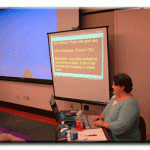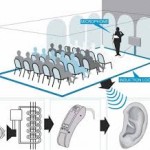Introduction
Are you prepared for workshop participants with reduced hearing? Those of us with little experience may tend to see all people with reduced hearing as falling into the same category – but nothing could be further from the truth. The only thing that people with reduced hearing universally have in common is lip-reading.
Reduced Hearing
There is a continuum of people with reduced hearing between two end-points – the Hearing Loss and the Culturally Deaf.
The Hearing Loss Community are those who are losing or who have lost their hearing. People in this category tend to:
- Consider themselves as having a sensory disability
- Be older and want to regain what they once had
- Have technological solutions to their hearing loss (eg, hearing aids).
The Culturally Deaf Community are those who have always had reduced hearing or lost their hearing very early in life before they learnt to speak. People in this category may:
- Have been born into a “deaf family”
- Want to be treated as a linguistic minority rather than as having a sensory disability
- Often use Australian Sign Language (AUSLAN) or the equivalent.
Of course, there is a diversity of people with reduced hearing between these two end-points. A deaf child born into a “hearing family” will tend to be guided to a technological solution. Then there are those with Chronic Disorders of the Ear – eg, tinnitus, Ménière’s Disease, etc – and those getting used to a cochlear implant.
Options
As a Workshop Facilitator or Meeting Organiser, you have a range of options to consider to ensure that people with reduced hearing can fully participate.
 AUSLAN Interpreters
AUSLAN Interpreters
AUSLAN Interpreters are highly skilled people who can translate the spoken word into AUSLAN in real-time so that AUSLAN speakers
Culturally Deaf People will benefit from the use of AUSLAN Interpreters in situations where verbatim conversation is essential to effective communication. Computer Assisted Real-time Translation (CART)
Computer Assisted Real-time Translation (CART)
CART is the instant translation of the spoken word into text by a highly-skilled operator somewhat similar to a Hansard Reporter. The text appears on a computer monitor or other display, such as a projector screen. CART is also often referred to as real-time captioning.
People with reduced hearing will benefit from the use of CART during group communication situations where verbatim conversation is essential to effective communication. Assistive Listening Devices
Assistive Listening Devices
There are a range of devices available for the home, the workplace and in public buildings to assist those with hearing aids get more out of every day communications.
Hearing Loop and Infrared Hearing Systems help people who use a hearing aid or loop listener to hear sounds more clearly by reducing background noise. They are often installed in meeting rooms, churches, theatres, cinemas, banks, and shopping centres.
Helpful hints
- Rule #1, asking whether everyone can hear you is not a good way to check if everyone can hear you; present this question in writing; it’s surprising how many people do this
- Hold functions in places with soft surfaces and furnishings – eg, carpet and curtains – the sound reflections in places with hard surfaces wreak havoc on hearing effectiveness
- If possible, spend time with attendees with reduced hearing prior to your workshop or meeting to get a clear idea of what their needs are
- With a large, public, live or videocast audience, consider the use of AUSLAN Interpreters, CART (Computer Assisted Real-time Translation), microphones and/or assistive listening devices
- If you decide to use an AUSLAN Interpreter or CART, spend time with the provider beforehand so that you understand how you can best make use of their services
- Consider sending out pre-reading and have handouts available at the meeting or workshop to facilitate better understanding and participation
- Always get the attention of a person with reduced hearing before you start speaking; use their name when speaking directly to them
- If people are lip-reading or signing, they need to have the speaker’s mouth or the AUSLAN Interpreter’s hands in good light
- When speaking, do not stand in front of a window, look down, look away, eat drink or chew gum, or hold a pen in your mouth; keep your hands away from your face; and lustrous beards can be a problem
- Speak clearly with a natural rhythm and probably a bit slower than you would normally; and do not shout as this distorts your face making lip reading difficult
- Make sure you allow time for AUSLAN Interpreters and/or CART Operators to catch up before moving onto a new issue
- Make sure you allow regular breaks for AUSLAN Interpreters and/or CART Operators as it is a very demanding role. This will ensure that they do not develop long term over-use injuries
- Use more visual clues to your messages; use slides, pictures, signs, or a pen and paper if necessary
- At the end of each session, unless advised otherwise, ask the person with reduced hearing to give you some feedback on what you have discussed; if they do not understand what you have said try rephrasing, writing things down or arranging a later time .
References & Acknowledgements
- This document is largely derived from several year’s experience volunteering with the ACT Deafness Resource Centre, as well as resource material from the Commonwealth Government and from the Resource Centre.
- Note that this advice should only be used as a guide to the types of issues that you should consider rather than as the “be-all and end-all” of advice. The Hub recommends that the ACT Deafness Resource Centre should be your first port of call if you need help.